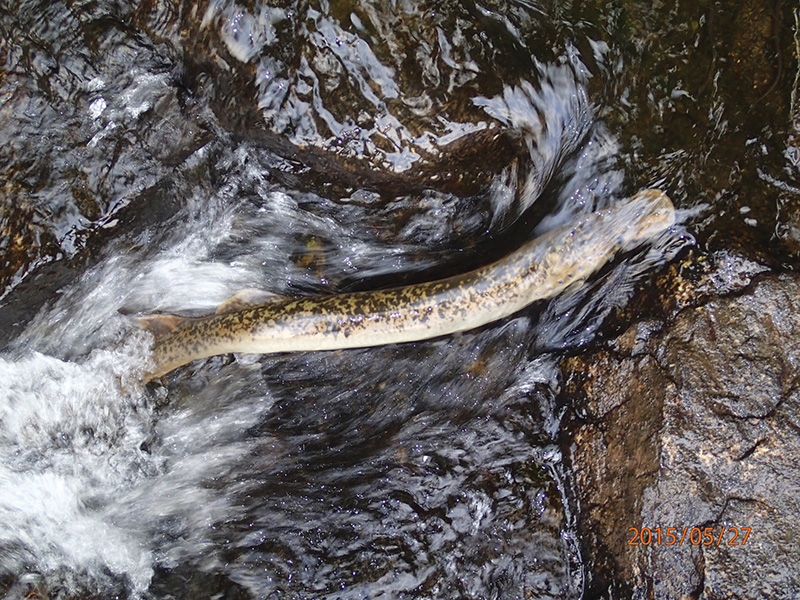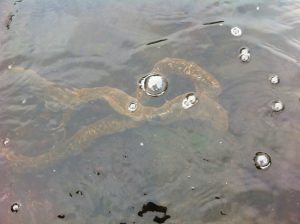
A lamprey struggling to surmount a small falls. It can attach to the rock and rest before bursting upstream. Images courtesy of Sally Harold.

Ugly is Good
Sea Lamprey in the River
By Steve Gephard and Sally Harold
Sea Lamprey in New England rarely get the attention they deserve. This species, whose looks many find repulsive, has a bad reputation that comes from its invasion of the Great Lakes, enabled in the mid-1800s by diversions from the Hudson and/or Susquehanna rivers associated with the construction of the Erie Canal. Once beyond Niagara Falls, the species colonized all of the Great Lakes and spawned in its tributaries. Instead of returning to the Atlantic, they used the lakes as their ocean, parasitizing Lake Trout and other native species that could not withstand the assaults like ocean hosts can. Populations of those native species have been decimated, and the US and Canadian governments have spent billions of dollars trying to curb the Sea Lamprey population. The story is different on the East Coast, where the fish is native.

A lamprey’s sucker mouth allows it to attach to rocks and drag them as part of nest building. The holes along the side of the fish are its gills.
The Sea Lamprey is a primitive species that starts life in freshwater as a tiny worm-like larvae called an ammocoete, which lives buried in the stream silt and sand and filter feeds on alga and bacteria. After about five years, it changes into a transformant that has eyes and a sucker-like mouth with rasping teeth designed to attach to other fish and feed on their blood as a parasite. But that feeding doesn’t start until it migrates into the ocean. It is anadromous, like salmon and shad, and after nearly two years in the ocean, it enters freshwater streams, ceases feeding, spawns and dies.
In New England and throughout East Coast rivers, the Sea Lamprey is an important component of the river ecosystem. In all life stages they provide food for other species, as adults they import critical “marine-derived nutrients” into relatively sterile glaciated streams, and, like beavers, they are environmental engineers. Yet, like other anadromous fish we have written about, their populations have been impacted by dams that have kept them from reaching historic spawning habitat.
In 2016, we completed a project to remove the Norton Paper Mill Dam on the Jeremy River in Colchester, Connecticut. This dam and others before it had blocked fish passage for almost 300 years. With the dam removed, we monitored habitat upstream to assess change and we remember the thrill of seeing lamprey nests—a testament to the ability of species to rebound when barriers are removed.
To take the accompanying photos (and the online video mentioned below), we donned wetsuits and slid into the Salmon River, a tidewater tributary of the Connecticut River. The water was clear and we swam slowly upstream through a deep pool to reach a shallow riffle where the increased water velocity threatened to sweep us downstream. We were no longer swimming, but rather crawling on hands and knees holding fast to ledge and boulders to maintain our position aside an active sea lamprey nest in about two feet of water. The nest was a depression about three feet wide and two feet long in the gravel-and-cobble streambed. Two adult lampreys, about 30 inches long and as thick as your summer zucchini, were still in the process of building the nest. They were blind and no longer feeding. Reproduction would be their final life act. As we watched, they used their sucker-like mouths to pick up rocks as large as tennis balls, dragging them backwards and depositing them on the downstream edge of the nest, forming a crescent-shaped gravel mound.

Once a nest is constructed, the male and female lamprey will intertwine and spawn in the nest.
Spawning only takes seconds but may occur repeatedly, over days. The female latches her mouth onto a large rock in the middle of the depression and the male latches onto her head and wraps his body around hers. As they release the sperm and eggs, they thrash violently. Fertilization is instant and the fertilized eggs fall into the nooks and crannies of the downstream gravel mound that they have built. Not all of the eggs make it to this incubation refuge because there is a party going on. While we lay in the shallow water to observe, we are surrounded by other fish. Some, like the Blueback Herring, pay no attention to the spawning lamprey but just struggle over the shallow gravel bar to reach upstream habitat. But downstream, an entire school of Spottail Shiners is lingering, intimidated by our presence and gobbling any errant eggs that are swept past the gravel mound. Dozens of Common Shiners, the males displaying vivid flashes of orange on their fins, are darting in and out of the nest, snatching the tiny eggs before they sink to the bottom. Even when an egg falls amongst the gravel, it may not be safe. As we watch, the heads of small American Eels—elvers—protrude from the gravel in search of eggs. A typical lamprey female will produce around 200,000 eggs, so there are enough to share.
When the spawning is complete, the exhausted male and female lamprey die. Their carcasses are devoured by important aquatic insects like caddisfly larvae, but the nests persist. Later, minnows will spawn over the gravel bars, and in the fall, trout may spawn in the same area, now possessing cleaner gravel since the lamprey have moved the rocks and let the current flush out the silt. In many streams, agency staff (often in coordination with the Connecticut River Atlantic Salmon Commission) and volunteers (e.g. the Connecticut River Conservancy) count Sea Lamprey nests in order to estimate run size and to gauge effectiveness of restoration efforts.
Historically, such nesting occurred throughout the watershed. Sea Lamprey was probably the only species other than Atlantic Salmon that could muscle its way over the chasm we call Bellows Falls in Vermont. The fact that it can ascend falls a little at a time, by latching onto rocks with its mouth and resting, allowed it to surmount falls and heavy rapids that shad and river herring could not. By the 1940s on the Connecticut River, lamprey were restricted to habitat downstream of the Holyoke Dam and fragments of tributaries downstream of the first dams on those streams. Suitable habitat required both gravel beds for spawning and silt and sand deposits for the ammocoetes. It was gravel beds that were in short supply in the lower river. Runs persisted below the dams on the Farmington and Salmon rivers and the falls on Roaring Brook and Higganum Creek. As fishways were built for shad and salmon, lampreys were also able to ascend the river and can now be found in many upstream tributaries including the Westfield, Mill, Fort Hill, West, Ashuelot, and White. Recently, a biologist with the US Forest Service watched lampreys spawn in the Third Branch of the White River near Rochester, Vermont—over 200 miles from Long Island Sound!
Let us reject the notion that we must kill all “icky” species like snakes, spiders, and insects while only embracing good-looking, charismatic species like pandas, whales, eagles, and salmon. The spawning Sea Lampreys remind us that the concepts of “beauty” and “ugly” are human constructs and are foreign to the natural world. From the perspective of a functioning ecosystem, all native species are “good” and “valuable” and, therefore, worthy of our appreciation and protection.
Would you like to see more? Join us underwater as we watch lamprey building a nest, Here’s a link to a little footage! EstuaryMagazine.com/lamprey.
Steve Gephard is a fisheries biologist. He recently retired after 40 years with the Connecticut Department of Energy and Environmental Protection Fisheries Division. He continues to work in the field as an independent consultant.
Sally Harold is an independent consultant for various fish passage and habitat restoration projects. Previously she worked as a fish restoration project manager for The Nature Conservancy.
After we submitted this column, we learned of the passing of David K. Leff of Collinsville, Connecticut. David was a contributor to this magazine and a well known poet. I got to know him when he was the Deputy Commissioner of the Connecticut Department of Environmental Protection (DEP), and he fought energetically to protect open space and rivers. I paddled several rivers with David as we strategized on projects. He was an attorney, public servant, poet, conservationist, hiker, naturalist, and lover of fish and rivers (particularly the Connecticut River’s largest tributary, the Farmington River). He will be missed. R.I.P., David. —SG

